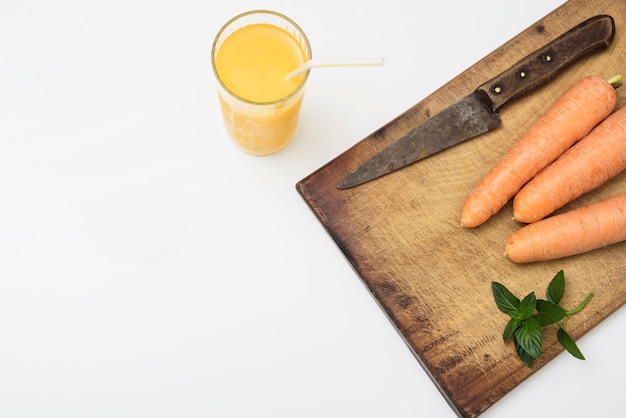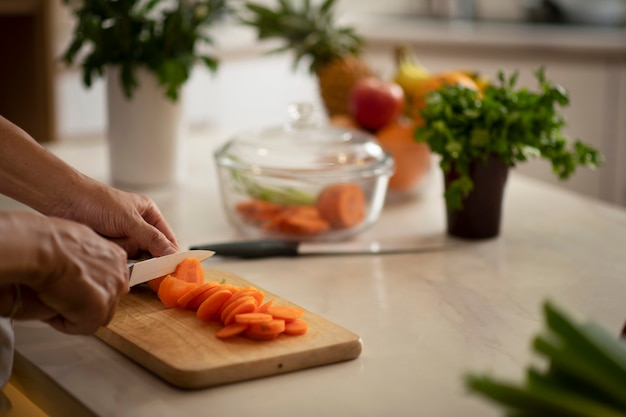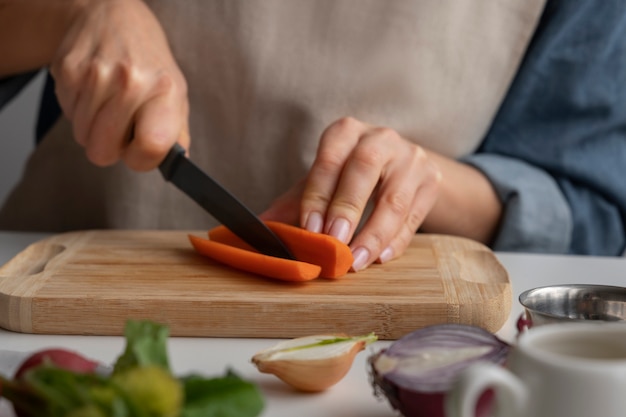Carrots, those humble orange root vegetables, hold a special place in my heart. I remember munching on them raw straight from the garden as a child, their sweetness bursting in my mouth. But as I grew older, I discovered that carrots were far more versatile than I'd ever imagined. From roasting and steaming to braising and adding them to soups and stews, the possibilities seemed endless. However, there was one hurdle I constantly faced: knowing how long to cook them for. It felt like a constant gamble – one minute they'd be crunchy, the next they'd be mushy, and I was never sure where that tipping point lay.
Over the years, I've experimented with countless techniques and recipes, determined to master the art of cooking carrots to perfection. And finally, I've cracked the code! I'm excited to share my findings with you, so you can confidently cook carrots to absolute perfection every time. Let's embark on this culinary adventure together!
Part 1: Understanding carrot varieties

The first step to perfectly cooked carrots is to understand the different varieties available. It's like trying to bake the same cake with different types of flour – the outcome won't be the same. Each carrot variety has its own unique characteristics, which influence how it cooks and tastes.
1.1 Baby Carrots
These tiny guys are the most common type found in grocery stores. They're usually uniformly sized and peeled, making them a breeze to cook. However, they tend to be a bit on the bland side, so they're often used in dishes where they'll be enhanced by other flavours. Think of them as the "blank canvas" of the carrot world.
1.2 Imperator Carrots
These are my personal favourite! They're long, slender, and have a vibrant orange colour. They're also super sweet and delicious, making them perfect for roasting or grilling. Their sweetness really shines through, and they add a beautiful depth of flavour to any dish. You might find them labelled as "Imperator" or "Chantenay" at your local market.
1.3 Nantes Carrots
These carrots have a slightly shorter and fatter shape than Imperator carrots. They're known for their excellent flavour and tender texture. They're a versatile choice, working well in soups, stews, and even salads. Their sweetness adds a beautiful depth to any dish, and they're sure to please even the pickiest eaters. You'll often find them in soups and stews, where their sweetness adds a beautiful depth.
1.4 Other Varieties
The world of carrots is more diverse than you might think! There are countless other varieties out there, with different shapes, sizes, and even colours. Don't be afraid to experiment and try something new! Some of my favourite varieties include:
- Purple carrots: These have a slightly earthy flavour and vibrant colour that adds a stunning visual appeal to any dish. They're a conversation starter and a delicious way to add a touch of whimsy to your plate.
- Yellow carrots: These have a milder flavour than orange carrots and a slightly sweeter taste. They're a beautiful addition to salads or roasted vegetable dishes, offering a subtle sweetness that complements other flavours.
- White carrots: These are a rare treat and have a delicate, sweet flavour. They're often found in specialty markets or farm stands. Their delicate flavour and unique appearance make them a culinary treasure.
The beauty of exploring different varieties lies in the unique flavour profiles they offer. So don't hesitate to branch out and discover your new favourite carrot!
Part 2: Preparing Your Carrots

Now that you understand the different varieties, it's time to get those carrots ready for cooking. This might seem like a simple step, but it makes all the difference in the final result. The key is to ensure that your carrots are clean, and the right size and shape for your chosen cooking method.
2.1 Scrubbing and Peeling
I usually give my carrots a good scrub with a vegetable brush under cold running water. This helps remove any dirt or grime, ensuring that you're starting with a clean canvas. If the skin is thick or tough, I'll peel them with a vegetable peeler. However, I often leave the skin on, especially for roasting, as it adds a nice bit of texture and flavour. The skin also adds a beautiful colour contrast to the roasted carrots.
2.2 Chopping and Slicing
The way you cut your carrots will affect their cooking time. Smaller pieces will cook much faster than larger ones, so it's important to choose the right size for your chosen method. Here's a quick guide to help you decide:
- Whole carrots: Great for roasting or braising. Keep them whole for a slightly longer cooking time, which allows the flavours to develop and the carrots to become beautifully tender.
- Large chunks: Perfect for soups, stews, or stir-fries. These will cook quicker than whole carrots, adding their sweetness and texture to your dish without overpowering other flavours.
- Sticks or coins: Ideal for roasting, grilling, or steaming. The smaller pieces will cook more evenly and create a delightful contrast of textures in your dish.
Part 3: Cooking Methods

Now that your carrots are prepped and ready, let's talk about the different cooking methods. Each method brings out unique characteristics of the carrot, offering a range of textures and flavours to choose from.
3.1 Roasting
My absolute favourite way to cook carrots is roasting them in the oven. It brings out their natural sweetness and creates a beautifully caramelized exterior. This method is simple, yet incredibly rewarding.
- Preheat your oven to 200°C (400°F). A hot oven is essential for achieving that perfect caramelized finish.
- Toss your chopped carrots with a drizzle of olive oil, salt, pepper, and any herbs or spices you like. This adds flavour and helps the carrots cook evenly.
- Spread the carrots in a single layer on a baking sheet. This ensures that the air circulates around the carrots, allowing them to roast evenly.
- Roast for 20-30 minutes, or until tender and slightly caramelized. Keep a close eye on them, and remove them when they're just tender, to avoid overcooking.
The key to perfectly roasted carrots is to ensure they have a slight bite. They should be tender but still have a bit of firmness to them. The caramelized exterior is a beautiful indicator of their deliciousness.
3.2 Steaming
Steaming is a quick and healthy way to cook carrots. It preserves their nutrients and flavour, making it a perfect option for a light and nutritious meal.
- Fill a saucepan with about an inch of water and bring it to a boil. The water should be steaming, but not boiling furiously.
- Place a steamer basket over the boiling water. This ensures that the carrots are cooked by the steam, not the boiling water, which can make them mushy.
- Add your chopped carrots to the steamer basket and cover the saucepan. The steam will cook the carrots evenly and quickly.
- Steam for 5-10 minutes, or until tender. Keep an eye on them, as the cooking time will vary depending on the size and thickness of the carrots.
steamed carrots are a blank canvas for flavour. They can be served simply with a touch of butter and salt or dressed up with herbs, spices, or a squeeze of lemon.
3.3 Braising
Braising is a great way to cook carrots when you want them to be incredibly tender and melt-in-your-mouth. It's a slower cooking method that allows the flavours to meld and the carrots to become beautifully soft and succulent.
- Heat some oil in a large pot or dutch oven. This will help to brown the carrots and create a base for the braising liquid.
- Brown the carrots on all sides. This creates a beautiful colour and depth of flavour.
- Add a flavorful broth or liquid, such as wine or stock. Choose a liquid that complements the flavours of the dish you're making.
- Bring to a simmer, cover the pot, and cook until the carrots are very tender, around 30-45 minutes. The simmering process allows the flavours to develop and the carrots to become incredibly tender.
Braised carrots are a luxurious addition to any meal, offering a beautiful tenderness and rich flavour.
Part 4: The Importance of Temperature
You've chosen your cooking method, but don't forget about temperature! It plays a crucial role in how quickly your carrots cook and whether they become tender or tough. Just like a good chef knows how to adjust the heat to create the perfect dish, you'll need to understand the impact of temperature on your carrots.
4.1 High Heat
High heat will cook your carrots quickly, but it can also lead to them becoming tough or even burning, especially for whole carrots or large chunks. This is because the exterior cooks faster than the interior, leaving you with a tough outside and an undercooked centre. For faster cooking, stick to methods like steaming or boiling, where the heat is more evenly distributed.
4.2 Low Heat
Low heat is ideal for methods like braising or roasting. It allows the carrots to cook slowly and evenly, creating a tender and flavorful result. It's best to use a lower temperature for longer cooking times, allowing the flavours to develop and the carrots to soften gently. This is the key to achieving that melt-in-your-mouth tenderness that makes braised carrots so special.
Part 5: How to Tell When Your Carrots are Done
Now comes the tricky part – knowing when your carrots are perfectly cooked. It's not about a specific time; it's about texture and appearance, which can vary depending on the cooking method and your desired outcome.
5.1 Texture
For most recipes, you want your carrots to be tender but still have a slight bite. You should be able to easily pierce them with a fork but not have them fall apart. This is the hallmark of a perfectly cooked carrot. It should be tender enough to be enjoyable, but still retain some firmness.
5.2 Appearance
Roasted carrots should have a slightly caramelized exterior, indicating that they've reached that sweet spot of perfect cooking. Steamed carrots should be vibrant orange and slightly softened, with a fresh and vibrant appearance. Braised carrots should be incredibly tender and almost melt-in-your-mouth, looking beautifully glossy and inviting.
Part 6: Cooking Times
Here's a general guide to cooking times for different carrot preparations. Remember, these are just estimates, and the exact time will depend on the size and thickness of your carrots, as well as your chosen method. It's always best to check the tenderness of your carrots as they cook to ensure they're cooked to your liking.
6.1 Baby Carrots
Baby carrots cook quickly because they're already peeled and small. Here's a breakdown of approximate cooking times for different methods:
| Cooking Method | Time |
|---|---|
| Steaming | 5-7 minutes |
| Boiling | 5-7 minutes |
| Roasting | 15-20 minutes |
Keep an eye on them as they cook, as they can go from tender to mushy very quickly.
6.2 Whole Carrots
Whole carrots take longer to cook, especially if they're large. This is because the heat needs to penetrate the entire carrot, which takes time.
| Cooking Method | Time |
|---|---|
| Roasting | 30-40 minutes |
| Braising | 45-60 minutes |
Be patient with whole carrots and allow them to cook slowly, as this will result in a beautifully tender and flavourful result.
6.3 Chopped Carrots
Chopped carrots cook much faster than whole carrots because the surface area is larger, allowing the heat to penetrate more quickly.
| Cooking Method | Time |
|---|---|
| Steaming | 8-12 minutes |
| Boiling | 8-12 minutes |
| Roasting | 20-25 minutes |
Keep an eye on them, as they can cook quickly, and you want to avoid overcooking.
Part 7: Tips for Perfect Carrots
Here are a few extra tips to ensure your carrots are always a success. These tips are based on my years of experience and are sure to help you elevate your carrot cooking game.
7.1 Don't Overcook
The biggest mistake people make is overcooking carrots. This makes them mushy and bland, and completely ruins their delicate sweetness. It's better to err on the side of undercooking, as you can always cook them a bit longer if needed. A slight firmness is better than mushy, so always check for tenderness, and remove them from heat when they're just cooked through.
7.2 Season Wisely
Seasoning your carrots is key to bringing out their flavour. Salt and pepper are essential, but don't be afraid to experiment with herbs and spices. Some of my favourites include:
- Rosemary: Adds a woody and earthy flavour, perfect for roasting or braising. It complements the natural sweetness of the carrots beautifully.
- Thyme: Adds a slightly lemony flavour that brightens up the dish, especially when used in steamed or braised carrots.
- Garlic: Adds a pungent and savory flavour, enhancing both roasted and braised carrots. A clove or two of garlic will add a delicious depth to your dish.
- Ginger: Adds a warming and spicy flavour that complements the sweetness of carrots, especially when used in stir-fries or Asian-inspired dishes. A little bit of grated ginger goes a long way, adding a unique and flavourful touch to your carrots.
7.3 Glaze for Extra Flavor
After roasting your carrots, you can add an extra layer of sweetness and depth by glazing them. Simply mix a bit of honey, maple syrup, or brown sugar with some water or broth and brush it over the carrots while they're still hot. The glaze caramelizes, creating a beautiful sheen and a burst of sweet flavour that elevates your dish to the next level.
Part 8: FAQs
Here are some of the most frequently asked questions about cooking carrots, addressed in detail to provide you with the information you need to confidently conquer your carrot cooking challenges.
8.1 Can I Cook Carrots in the Microwave?
Yes, you can microwave carrots. Simply place chopped carrots in a microwave-safe dish with a little bit of water and cook on high for 3-5 minutes, or until tender. However, microwave cooking doesn't bring out the same flavour as other methods. If you're looking for a quick and easy way to cook carrots, the microwave can be a convenient option, but it won't result in the same caramelized or tender results as roasting, steaming, or braising.
8.2 Can I Freeze Carrots?
Yes, you can freeze carrots. Blanch them first by boiling them for a few minutes, then cool them in an ice bath. This helps preserve their colour, texture, and flavour. Drain and dry the carrots before freezing in airtight containers or freezer bags. Frozen carrots can be added to soups, stews, or used in other recipes where their texture won't be a major concern.
8.3 What Can I Do with Leftover Carrots?
Leftover carrots are incredibly versatile! They're great for adding to soups, stews, or salads, adding their sweetness and texture to your dishes. You can also use them to make carrot puree, which can be added to smoothies or used as a base for dips. Carrot puree is also a delicious and healthy ingredient for baby food or toddler meals.
8.4 Why are my Carrots Still Crunchy?
If your carrots are still crunchy, it might be because you haven't cooked them long enough. Try cooking them for a few more minutes, or until they reach the desired tenderness. You can also use a fork to check for tenderness, as it should easily pierce the carrot without resistance. If your carrots are still crunchy, you can always add a few more minutes of cooking time, keeping an eye on them until they reach the desired texture.
8.5 Why are my Carrots Mushy?
Overcooked carrots are mushy, which is a common problem. To avoid this, be careful not to cook them for too long. Use a fork to check their tenderness, and remove them from heat once they are cooked through but still have a slight bite. Keep an eye on your carrots as they cook, and don't hesitate to remove them from the heat if they're starting to become mushy.
I hope this guide has helped you unlock the secrets to perfectly cooked carrots. Experiment with different varieties, cooking methods, and seasoning techniques to create your own signature carrot dishes. Happy cooking!
Everyone is watching

Corn on the Cob: The Ultimate Guide to Perfectly Cooked Ears
Healthy MealsAh, corn on the cob. Just the name evokes images of sunny days, barbecues, and that sweet, juicy flavour that ...

Perfect Pork Roast Oven Cooking Time: A Guide to Delicious Results
Healthy MealsThere's something truly satisfying about a perfectly roasted pork. The aroma alone is enough to make your mout...

Ham Cooking Time: How Long to Bake, Smoke, or Boil a Delicious Ham
Healthy MealsAh, ham. It's a classic, isn't it? A real crowd-pleaser, especially around holidays. And when done right, it'...

Scallops: The Ultimate Guide to Perfect Cooking
Healthy MealsAh, scallops. Those delicate, sweet, and utterly delicious morsels of the sea. They hold a special place in my...

Spaghetti Squash: The Ultimate Guide to Cooking and Serving
Healthy MealsRemember that time you saw spaghetti squash at the supermarket, looking all bumpy and strange, and thought, "W...
